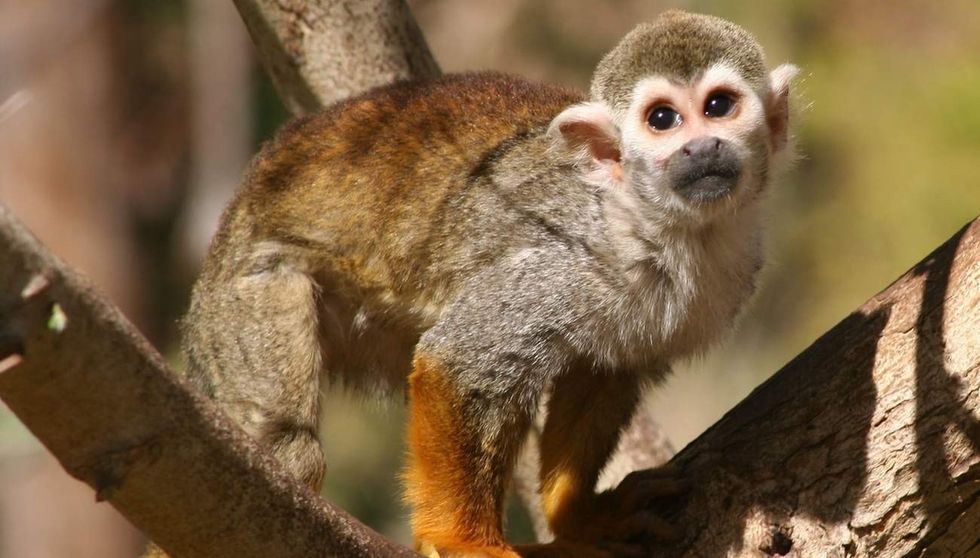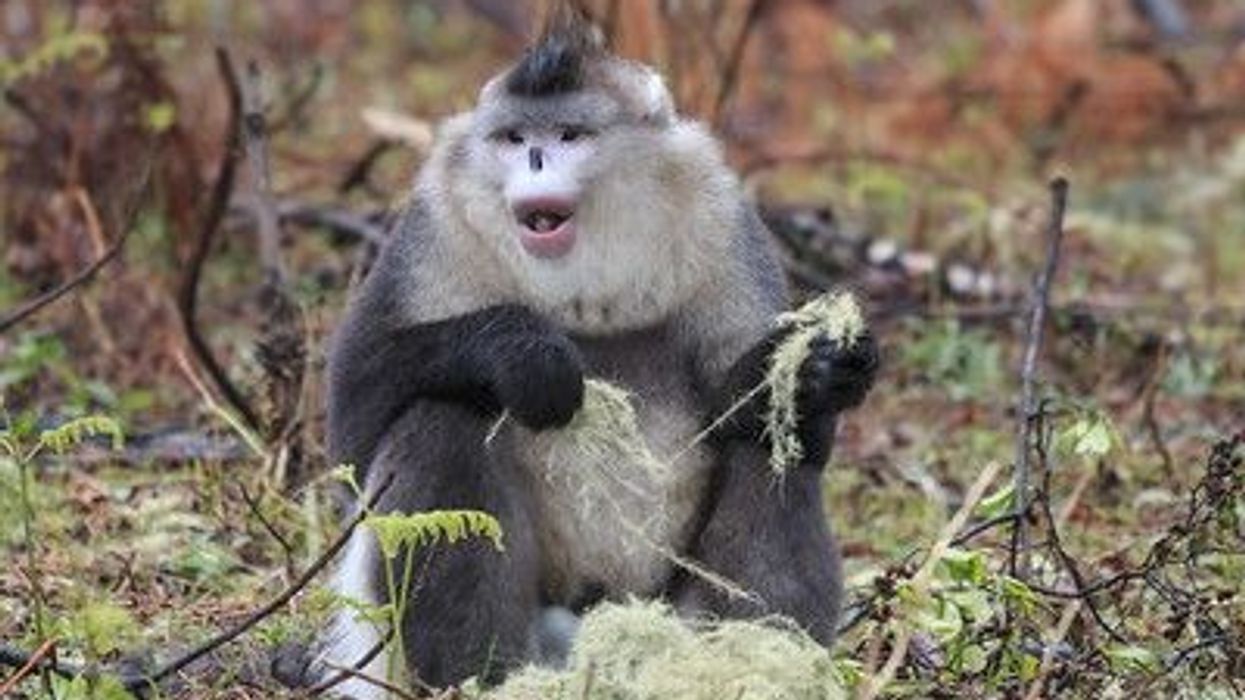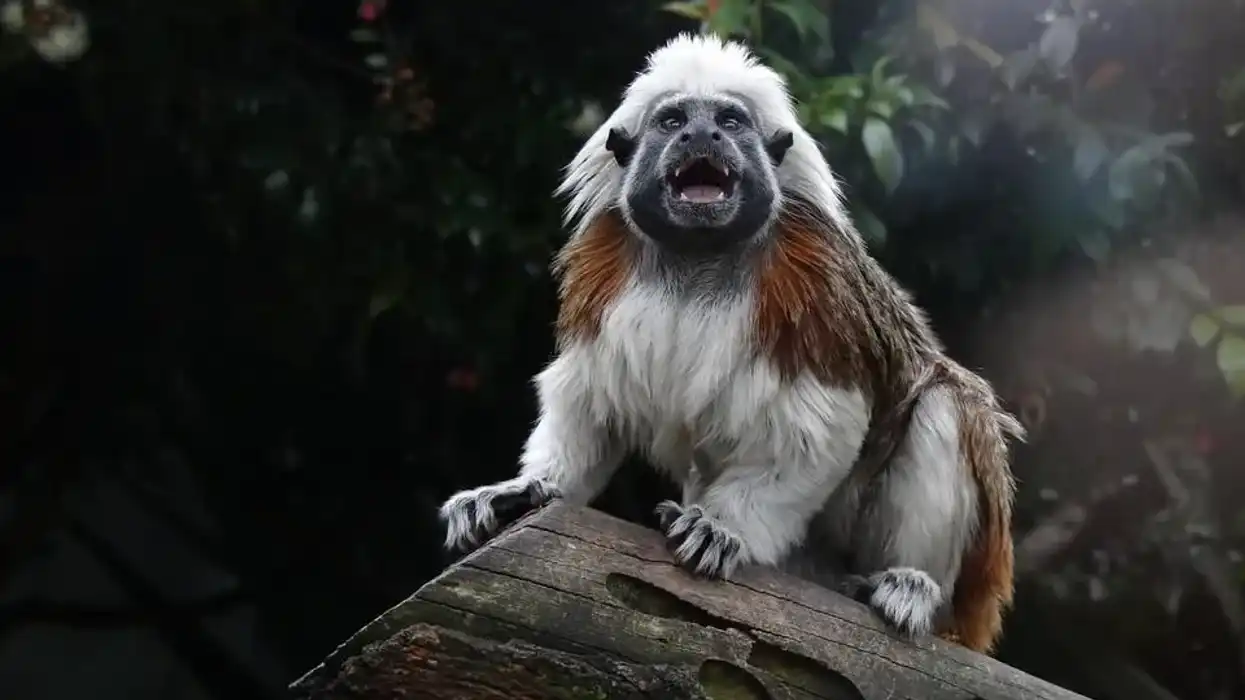Squirrel monkeys are a species of small New World monkeys that are known to inhabit tropical forests in central and southern American regions.
Even though they are tiny in size, they can measure up to over double their body size when measured with their glorious tails.
Although it is technically legal to keep squirrel monkeys as pets in parts of the United States, as well as in England and Wales in the United Kingdom, it is probably better not to as they thrive when spending the majority of their lives in trees, and it is almost impossible to create that environment in our homes.
So, even though they can be purchased with the click of a mouse on various websites at about $8,900, they do not make ideal pets.
Please read on to learn some more fun facts about squirrel monkeys, and hopefully this article will feed your curiosity about these monkeys of the family Cebidae.
Squirrel Monkeys Interesting Facts
What type of animal are squirrel monkeys?
As evident by their names they are monkeys who were nicknamed after squirrels because of their tiny size, as well as the fact that they are incredibly agile in nature.
What class of animal do squirrel monkeys belong to?
Like all primates, these animals are mammals, their scientific name being Saimiri sciureus.
How many squirrel monkeys are there in the world?
It is hard to say just how many squirrel monkeys are there in the world as they are not listed as a species at threat, but numbers of the Central American squirrel monkey have been decreasing drastically recently and there are believed to be around 5000 squirrel monkeys left in the world.
Where do squirrel monkeys live?
The common squirrel monkey is a kind of umbrella term that has been used to describe several species of Saimiri sciureus that are known to inhabit the tropical forests of South America around the Amazon basin. Some species are also known to inhabit areas that have been deforested for agricultural purposes, while others are found in Central America.
What is a squirrel monkey's habitat?
The squirrel monkey is known to often live around water bodies, seemingly for safety purposes. These species of New World monkeys also tend to inhabit the middle branches of the canopy structure of the forests, rarely going upwards or down onto the ground to prevent being caught by South American deadly predators.
Who do squirrel monkeys live with?
The common squirrel monkey is extremely social, and can sometimes live in groups of between 300 and 500 monkeys. Different groups of these diurnal creatures (diurnal meaning that they are most active during the day) are also known to sometimes hunt for food together.
Common squirrel monkeys are not known to be particularly territorial, though they do not stray very far from Central and South America, which is their natural habitat.
How long do squirrel monkeys live?
Common American squirrel monkeys can live for up to 25 years!
How do they reproduce?
Male squirrel monkeys often have to battle for the attention of female squirrel monkeys. The winner among the males then gets the right to mate with most of the females.
The breeding season generally lasts from September to November. After the females give birth, they tend to chase away the males as they do not really help to raise the infant. These primates of the family Cebidae reach maturity between three and five years of age.
What is their conservation status?
While some species of squirrel monkeys are listed as a species of Least Concern, others are considered to be in quite a vulnerable position. The main reason for this could be the exotic pet trade, as well as the habitat loss due to deforestation for agricultural purposes that has also led to food shortages for squirrel monkeys.
Squirrel Monkeys Fun Facts
What do squirrel monkeys look like?
Saimiri sciureus (or squirrel monkeys) are the smallest members of the primate family Cebidae, which are found in the South American region. They have short gray fur, a tuft of darker hair on their forehead over their white face, bright yellow legs, and a black or dark brown muzzle.
The Central American squirrel monkey is also called the red-backed squirrel monkey because of the distinctive orange fur on its back. Their long tails, which are measured at more than half of their body length, help them with their balance.
How cute are they?
These tiny animals are incredibly cute with their mask-like faces and long tails with bushy tips, which they are known to keep draped over one shoulder. Cute, right? Their cute looks are probably why they have become vulnerable targets for pet trades, both in their native lands of Central and South America as well as all around the world.
How do they communicate?
They are known to communicate with each other using various vocal signals.
How big are squirrel monkeys?
Squirrel monkeys are known to grow somewhere between 9.8-13.8 in (25-35cm) tall, without measuring their tails, which can grow anything between 14-17 in (35-42 cm) long. Their tail is about the same size as a lynx when they are standing upright.
How fast can squirrel monkeys move?
Some adult squirrel monkeys can move as fast as 22 miles per hour, how cool is that!
How much do squirrel monkeys weigh?
Males of this species can weigh between 1.56-2.4 lb (0.7-1.08 kg) while the females generally weigh between 1.1-1.56 lb (0.5-0.7 kg), which is almost the same weight as a big rat.
What are their male and female names of the species?
There are no particular specifications for the names of males and females of the Saimiri species. They are merely called male squirrel monkeys and females squirrel monkeys. Easy to remember, right?
What would you call baby squirrel monkeys?
Just like with humans, babies of squirrel monkeys are also called infants. People keeping squirrel monkeys or other primates as pets sometimes have been known to treat their babies similar to the way they would treat human children.
This is wrong and unfair on the monkey infants, who should be treated and cared for according to their own specific needs.
What do they eat?
Squirrel monkeys are known to be omnivores, and their diet consists of fruits, flowers, nuts, bird eggs, insects, lizards, and other small animals.
Are they loud?
Yes, they are pretty loud creatures. They use loud vocal signals to communicate with each other.
Would they make a good pet?
Even though they are extremely cute, they would not necessarily be good pets, as they thrive in the middle levels of forests, and it is impossible to create that kind of environment at home. In fact, the pet trade has been quite damaging to populations of squirrel monkeys over time.
Did you know...
Intelligent, social, and sometimes very human-like in their nature, primates are as interesting as ever, and probably the smallest and cutest of the primate order are the species of squirrel monkeys. They are loud, vocal, and social to the point where they are known to live in groups of between 300 and 500 monkeys.
Did you know that, even though they are most active during the day, they are able to differentiate between the voices of the members of their group, so that they can keep on communicating even when they cannot see each other because of the dark? They have between 25 and 30 different kinds of calls.
Their genus name, Saimiri, originates from Native South American languages, and means "small monkey".
This species is considered to be one of the most intelligent species of monkeys, due to their large brain and small body ratio.
Did you know that their tail is not really prehensile, meaning it cannot be used to grip branches like other primates? However, their big bushy tipped tails still help them immensely with their balance.
Can squirrel monkeys be pets?
While it is technically legal to keep squirrel monkeys as pets, it is not really advisable, as the numbers of some members of the species are in decline due to excessive pet trading.
They can also become aggressive once they reach maturity and might bite you, which could turn out to be really dangerous as like other primates they are known to carry some deadly diseases.
Different types of squirrel monkeys
There are different types of species in the squirrel monkey family, such as the common squirrel monkey (Saimiri sciureus), Central American squirrel monkeys (Saimiri oerstedii), the bare-eared squirrel monkey (Saimiri ustus), and the bare-capped squirrel monkey (Saimiri boliviensis). Their names indicate their physical attributes as well as in some cases their habitats.
Have you ever been lucky enough to see one of these squirrel monkey species in the wild?
Here at Kidadl, we have carefully created lots of interesting family-friendly animal facts for everyone to discover! You can even occupy yourself at home by drawing one on our squirrel monkey coloring pages.









